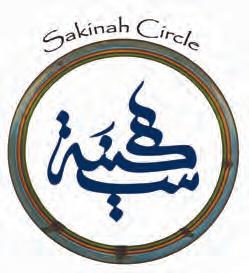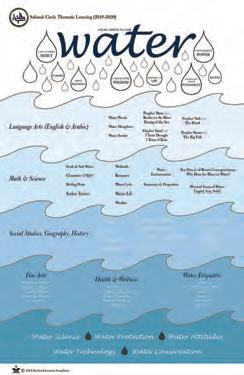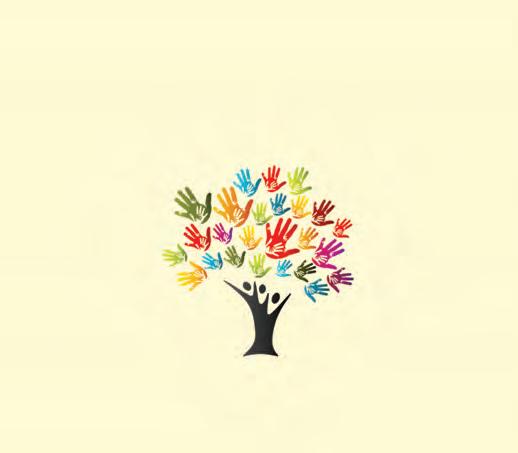
7 minute read
Nurturing Awe and Wonder
Nurturing Awe and Wonder in Early Learning The Quranic worldview cannot be compartmentalized
BY ELMA HARDER
Advertisement
The idea of teaching with a Quranic worldview started when we b egan homeschooling. I shared the educational philosophy that grew during that experience and many ideas about it in my “Concentric Circles: Nurturing Awe and Wonder in Early Learning” [in consultation with Muzaffar Iqbal] (Muslim Education Foundation, Canada, 2006)
We shared the book with our home education center’s principal to explore ways to support Muslim homeschooling families. The ideas kept germinating and eventually the book became the foundational text of the Sakinah Circle Alternative Program, a new initiative rooted in Edmonton Public Schools that delivers the Alberta Program of Study through the lens of the Quranic worldview.
This is how Sakinah Circle’s vision has taken shape in the classroom.
A FOUNDATIONAL APPROACH TO LEARNING
This foundational text provides a Quranic worldview based on two core ideas: Every human has an inborn fitra, a primordial imprint deep in the spiritual realm of our being, deposited through a covenant established by the Creator (Q 7:172). The recognition of the Creator embedded in the nature of all human beings leads to the recognition of our place on Earth as vicegerents (khulafa’) of God.
Each of our book’s six chapters explores how this worldview shapes the learning process by establishing a Quranic orientation to the topic and then presenting a kaleidoscope of layered activities so learning can grow with the widening circles and reflect best practice. Thus, learning is always connected and unfolding from the central core.
These chapters are: ■ The Two Learners: Every learning and teaching environment features the young and the not-so-young. The parents and teachers, who function as facilitators, must recognize and nurture the child’s original fitra and provide a meaningful learning process.
■ The Space: As the learning environment is a powerful teacher, we can design nurturing places that help focus our learning, convey a sense of orientation, eliminate distractions and demonstrate a unicity within it. ■ Time: The quality of our time, which is directly related to our spiritual state, begins with intention. We can plan our days, routines and celebrations while reflecting on what makes something meaningful and how our learning activities can be rooted in the Quranic worldview. ■ The Languages: A child’s first language is the language of fitra, which communicates the essential inner reality of things. Over time, languages are learned via articulated speech, symbols, patterns and signs of the cosmos. The languages of revelation and faith open yet more realms of understanding. ■ The Straight Path: We seek to plant the seeds of a lifelong relationship with the Qur’an. Young learners can learn to consciously walk, step by step, on it with an integrated worldview rooted in the Book. ■ Threads & Themes: Like the warp and weft of tapestry, threads of ideas can be woven into strong enduring concepts in the learning experience. This chapter outlines the framework of conceptual teaching drawing on Quranic themes.
Three themes — Beginnings, The Garden and Tazkiyah (a striving that leads to success in this life and the next) — are developed into detailed teaching units with lessons and integrated activities.
“Concentric Circles” encourages those who teach and learn to reflect and creatively reassess the “what,” “why” and “how” questions of education. Designed for committed Muslims and based on the belief that all of us are here for a purpose and that together we can learn and understand how to live with intention and meaning, this book conveys the kind of learning that is both transformative and touches all learners at all levels.
SAKINAH CIRCLE
Shortly after its publication, the Muslim Education Foundation partnered with the Argyll Centre for Home Education, which is part of Edmonton Public Schools, to host “Doorways to Islamic Civilization.” Initially an afterschool program for homeschoolers, it led to a full-time pilot program that, in 2010, became the Sakinah Circle Alternative Program.
This programseeks to engage in a process of education that brings us closer to the Creator — a process of learning based on the Quranic worldview that encompasses all curricular disciplines to develop critical minds, conscious hearts and compassionate human beings.

Its mission is to provide guidance and an environment that recognizes the learner’s fitra, nurtures taqwa (Godconsciousness) and cultivates learners who strive to become khulafa’.
Sakinah Circle is a unique alternative program within Grace Martin Elementary Public School. It teaches the Alberta Program of Study and its programming is based on a philosophy of education derived from the Quranic worldview, demonstrated by its curriculum content, the way it is delivered and the learning environment.
In the curriculum documents, reflective questions
accompany each learning outcome to orient teacher thinking with the Quranic worldview. Enduring understandings are identified for each general learning outcome of the K-6 Alberta Programs of Study, among them: ■ Signs and symbols in the natural world point us to our Creator and Sustainer. ■ There is harmony in the cosmos. and time. We are here for a purpose and will return to the Creator. ■ Language is a divine gift to be appreciated and treated as an amana (trust). ■ All prophets brought the same essential message: to remember God. ■ Sakina is the fruit of inner harmony and outer balance.
We aspire to internalize sakina (calmness, tranquility) and make it externally visible by striving to balance the physical body via good nutrition, regular exercise and lifestyle habits of care and wellness. Strategies to nurture inner harmony include becoming mindful, observing the signs around us and focusing on sincerity of the heart and mind. Every classroom displays the five critical attributes: to be intentional, responsible, respectful, real and reflective individuals.
The program’s three pedagogical pillars are: ■ We are nature-focused to increase each child’s connection to the cosmos and to nurture awe and wonder in creation. ■ We are historically rooted to find our meaningful place in the timeline of history, connecting with our family and community roots and learning about Islamic civilization and
■ We have a place in space
traditions.
■ We are service-oriented to be intentional about good deeds, stewardship and becoming compassionate human beings with critical minds and conscious hearts.
Every year, a theme connects our learning across subject areas at all grade levels. Themes like “The Garden,” “The Skies” and “Nourishment” are multifaceted Quranic concepts with layers of significant connections to the curriculum. “The Traveler,” for example, explored both modes of transportation and how life is a journey and the reasons for travel (to learn, work, migrate or go on pilgrimage) and allowed us to focus on Trade and Travel on the Silk Road.
This last year’s theme, “Water”, as depicted on the poster, was integrated into all subject areas with the Quranic worldview at the top, coming down in raindrops; subject areas are indicated in the waves, with curriculum connections and some links to Islamic civilization and tradition; the bottom wave lists five general topics of water study (see our video “Wonders of Water” https://gracemartin. epsb.ca/programs/sakinahcirclealternativeprogram).

At the virtual June 2020 graduation ceremony, we bid farewell to our seventh cohort of sixth graders with the following [condensed] speech:
Alhamdullilah, we’re celebrating your journey of learning in a rapidly changing world as you move from elementary school to junior high school.
What have you gathered here in Sakinah Circle to carry to your next destination? What remains with you from
Sakinah Circle’s thematic learning? What have you learned about being a responsible, respectful and reflective person who has roots in your family and Islamic traditions, knowing that you are connected? Have you learned to be a person who looks at the cosmos and the natural world with wonder and awe; who begins the day with intention; is alive for a purpose; and has reason to do good deeds, to work for justice, to be a compassionate human being? A person who keeps trying to see the signs that guide us on the journey of life? We are always learning, looking, listening, seeing and hearing — seeking to understand the world around us and inside of us. Let’s remember to take a deep and quiet breath when things are easy or hard and to remember what’s important. With your energy and enthusiasm, your beautiful hearts and great dreams, you are the class of 2020. May your vision be very sharp. May Allah always put Light on your path. We wish you all the best. Bismillah. ih
Elma Harder, teacher and author of Concentric circles: Nurturing awe and wonder in early learning [in consultation with Muzaffar Iqbal], is program specialist in the Sakinah Circle Alternative Program, Edmonton Public Schools. She develops resources that bring the Quranic worldview into Sakinah classrooms. She can be reached at elma.harder@gmail.com.
ISNA Monthly Sustainer –A Good Deed Done Regularly! You can make an impact with as little as $10 per month!









